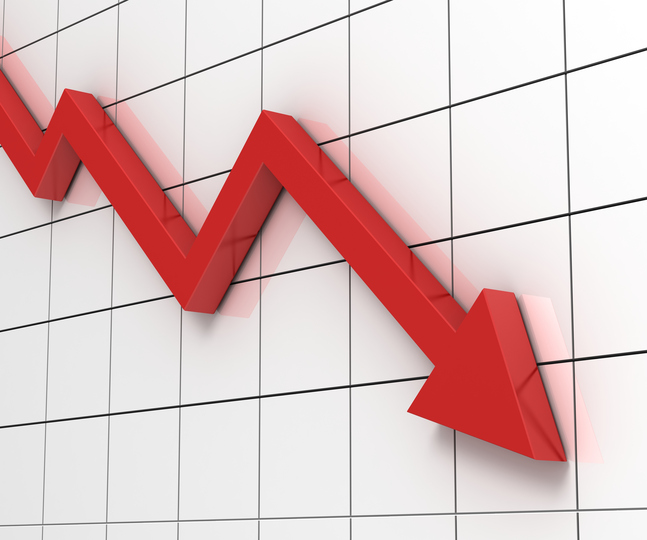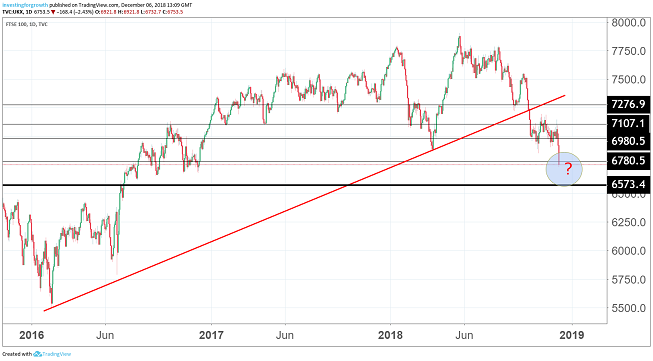FTSE 100 crashes again, but where will it bounce?
6th December 2018 12:51
by Graeme Evans from interactive investor
After another spectacular plunge, the FTSE 100 hasn't been this low since 2016. Graeme Evans explains why and what might happen next.

With today's tumultuous session leaving the FTSE 100 Index 12% lower for 2018, not even the London market's customary Santa rally will be sufficient to prevent the top flight from finishing the year deep in the red.
It's been a nightmare period for global financial assets, even though analysts at Barclays rightly point out that not one major economy is near recession and there's been no financial meltdown or significant debt default.
What's driven this year's sell-off is an accumulation of economic jitters, political risk and country specific issues such as Brexit. The effects of recent trade wars are now priced in, but what's spooked investors today is that the arrest of the CFO of Chinese telecoms firm Huawei signals a potentially deeper conflict.
There's also no escaping this week's message from bond markets, with US Treasury yields on five year bonds below three year bonds for the first time in more than a decade to suggest that a recession could be on the cards.

Source: TradingView (*) Past performance is not a guide to future performance
Friday's non-farm payroll release in the US will now take on extra significance, particularly amid worries around a slowdown in the US housing market. The best outcome for investors may be that this turmoil leads to a softening in the Federal Reserve's language in relation to the interest rate cycle.
In the meantime, markets appear to have overlooked the fact that 2018 earnings delivered a better performance than we expected at the start of the year, focusing instead on the single-digit earnings growth forecast in 2019.
Barclays analysts, however, don't think 2019 will turn out as badly as in 2018.
They said today: "At some point next year, the Fed will likely approach the end of its hiking cycle. We expect the world's major economies still to grow at or above trend. And risk assets are more reasonably priced after the year-long pullback.
"On the other hand, global growth should be a little weaker in 2019 than in 2018, which itself was held back by surprisingly weak eurozone growth."
As we highlighted from UBS yesterday, cyclical stocks are trading at an attractive 20% discount if you think the economic outlook is better than many think.
Barclays said that investors need to lower their expectations and stay nimble:
"After years of positive returns and low volatility in the run-up to 2018, investing is set to become more challenging in the quarters ahead."
Richard Hunter, interactive investor's head of markets, says: "Global economic growth may be subject to a synchronised slowdown, in much the same way that the recent upturn was, for the most part, enjoyed worldwide.
"As such, and in the absence of any near-term catalysts, markets will remain under pressure, particularly the UK where the unknown ramifications of Brexit make the region 'uninvestable' to some international institutional investors."
The only hope for the rest of 2018 is the annual market cliché in the form of the Santa rally.
Our research found that this phenomenon has occurred every year without fail, with the average Santa rally in December since 1998 being 5.8%, with the highest being 12.2% in 2008.
From today's level 6,750, even a repeat of the 2008 festive bonanza would still leave the FTSE 100 Index a few points short of where it finished 2017 at 7,687.
But the sell-off has been predicted by our technical analyst Alistair Strang. Less than a month ago, he wrote:
"Unless the FTSE somehow exceeds blue - roughly 7,160 at present - there's still a heck of an argument favouring bottom somewhere around 6,600 eventually."
Today, his bespoke software forecasts a bounce at 6,574.
- Where next for FTSE 100 as Brexit deal unravels?
- Is a Santa rally guaranteed this December? Computer says 'yes'
Tech stocks in Asia were behind today's global markets slump, falling sharply in reaction to the Huawei arrest in Canada and leaving a broad range of sectors caught in the subsequent fear-driven sell-off.
Casualties included miners, with Antofagasta down 7% in the FTSE 100 Index and KAZ Minerals off 8% in the second tier. Prudential, which is heavily focused on Asia, slid another 6% to leave the stock 20% lower since mid-September.
The session added to the recent woes for Thomas Cook, which fell 12% to 30p after benefiting from a rare session on the front foot yesterday. The fall-out from last week's second profit warning in three months has left the company worth little more than its debt pile of £389 million.
*Horizontal lines on charts represent levels of previous technical support and resistance.
These articles are provided for information purposes only. Occasionally, an opinion about whether to buy or sell a specific investment may be provided by third parties. The content is not intended to be a personal recommendation to buy or sell any financial instrument or product, or to adopt any investment strategy as it is not provided based on an assessment of your investing knowledge and experience, your financial situation or your investment objectives. The value of your investments, and the income derived from them, may go down as well as up. You may not get back all the money that you invest. The investments referred to in this article may not be suitable for all investors, and if in doubt, an investor should seek advice from a qualified investment adviser.
Full performance can be found on the company or index summary page on the interactive investor website. Simply click on the company's or index name highlighted in the article.